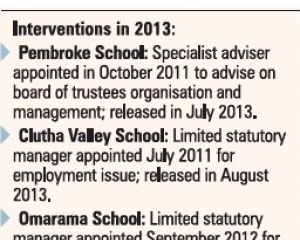
When IFP pupil numbers slumped from a 15-year high of 700 in 2003 to 389 in 2006, some Otago principals warned some schools could fall into a financial deficit if the trend continued.
The concern was shared by principals across the country, with nationwide IFP pupil numbers dropping from about 17,500 to 7204 over the same time frame.
The plummet was believed to have been influenced by several factors, including the collapse of some high profile private schools, resulting in the Chinese Government placing severe restrictions on activities by New Zealand education providers, the global financial crisis and the Sars virus.
Many Otago secondary principals said international pupils had been bolstering their school finances for many years, and if numbers dropped too low, school deficits would be even worse than they already were.
It was believed each international pupil contributed up to $30,000 to the local economy through school tuition, accommodation, school uniforms and school trips as well as personal spending; and parents of international fee-paying pupils who came to visit did the same through spending on flights, accommodation and other living expenses.
However, fears about the impact on school budgets have been eased as recently released ministry statistics show the numbers are stabilising, with an average of 472 IFP pupils enrolling each year in Otago secondary schools, and an average of 7812 nationwide.
During the past two years, the numbers have increased by 5%, from 487 in 2012 to 511 in 2013. It is a trend reflected nationally.
Otago Secondary Principals' Association chairman Mason Stretch was pleased the numbers appeared to be settling, and was delighted there had been a minor increase in 2013.
He believed a contributing factor was the resurgence of the global market.
''The global recession has certainly moved on.
''That was probably a major part of it, especially with our major markets where our students are coming from.
''I don't think there has been any difference in terms of school promotion or New Zealand-led national promotion.
''I think it's a function of things beyond our control really. It's been caused by global factors,'' Mr Stretch saidNumbers at his school, Cromwell College, had dropped by more than 50% several years ago, but the school was slowly building the numbers back up again, he said.
An Education New Zealand spokeswoman said New Zealand had worked hard in recent years to rebuild its reputation in China, and now had a very positive education relationship with China, which remains New Zealand's largest market.
''We are deliberately not seeking to see a rapid explosion in low quality courses and providers that we saw in the early 2000s.
''We are seeking to grow our numbers and the value of the industry in a more sustainable way.
''The focus is on overall income rather than raw student numbers, and that places the emphasis on higher-level students studying for longer.''
She said the latest snapshot of IFP pupil numbers ( for 2013) indicated several positive trends by sector when compared with 2012.
''Universities, institutes of technology and polytechnics, and secondary school numbers grew, while primary school and private training establishment numbers were down.''
- john.lewis@odt.co.nz
Advertisement





